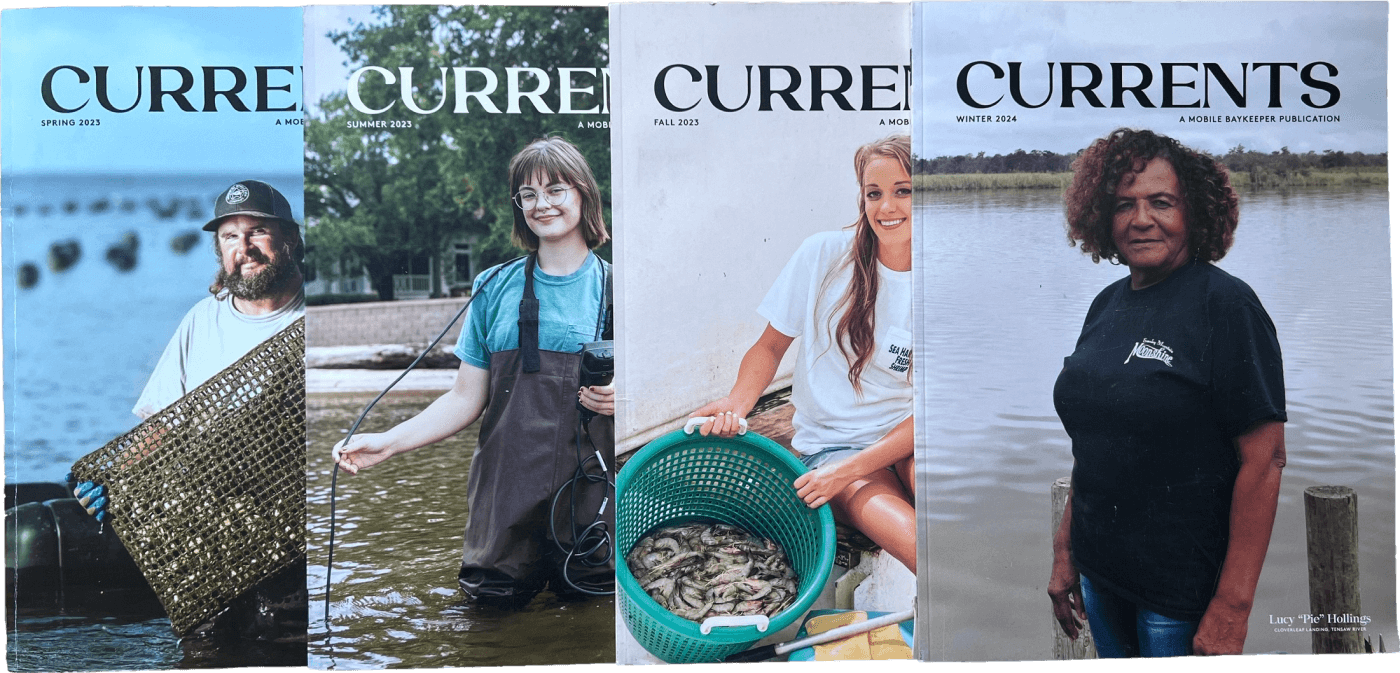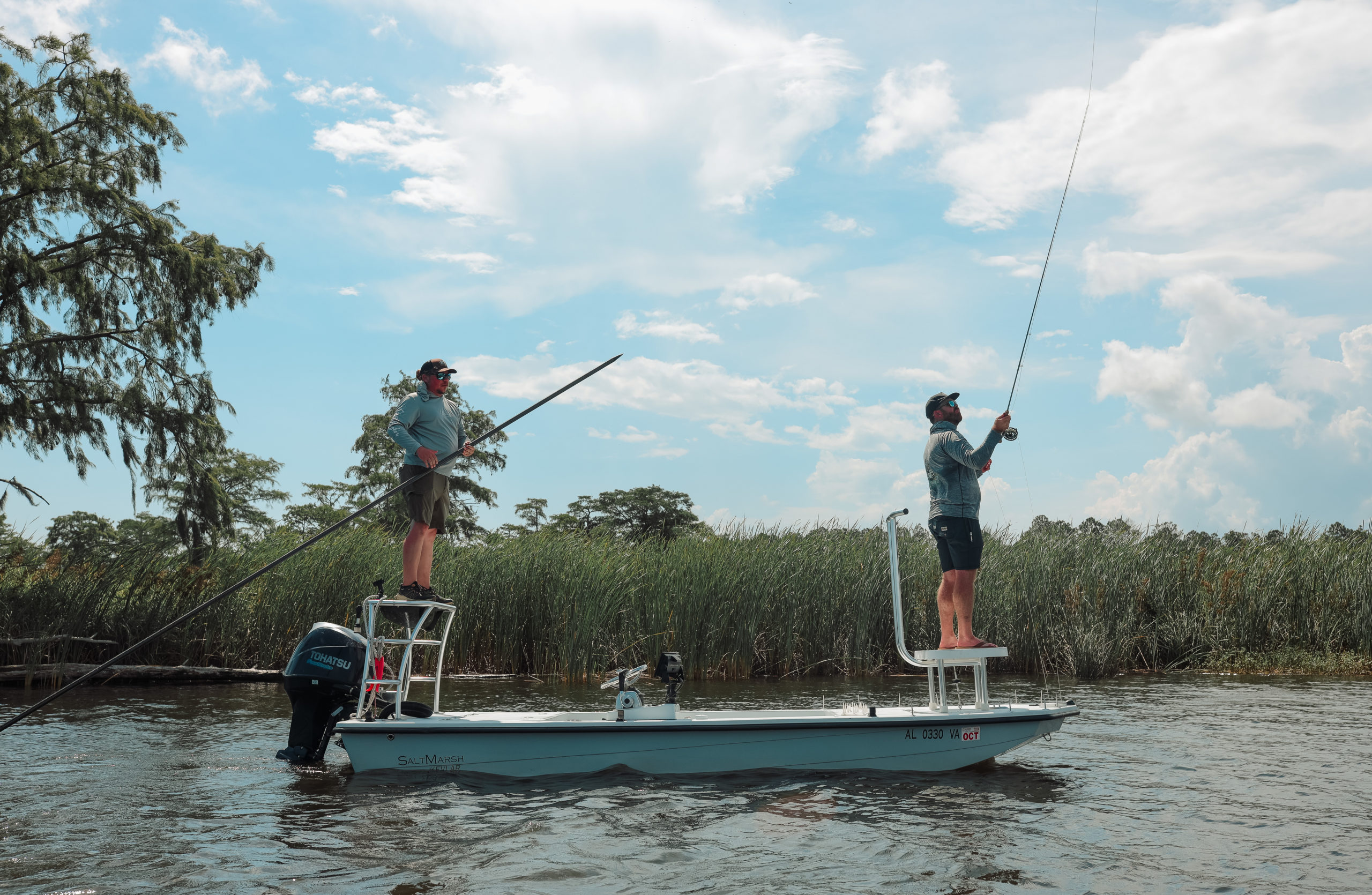
This article is from the fall 2024 edition of Mobile Baykeeper’s print quarterly, CURRENTS. The magazine is mailed to active members who have given more than $50 in the past year. To get on the magazine’s mailing list, donate here.
by Sam Wilkes | Photos by Courtney Mason Hilley
When you watch the aerial loop of a fly line unroll into a straight and silent presentation, it’s easy to appreciate the dedication required for the sport. Fly fishing is not for those seeking immediate gratification. It’s more of a holistic journey — from customizing your fly, to stretching your line, to tying your leaders, to practicing your different casts, to learning feeding patterns, to stalking a fish — all culminating in a presentation hopefully attractive enough to entice a bite. It is the antithesis of today’s on-demand culture. Yet, there appears to be a growing interest in our area. A place with a relatively young history with the sport, Mobile Bay does not come first to mind when talking about fly fishing. Far from the rippling mountain streams or the turquoise flats of the Bahamas, our area presents its own unique traits and challenges.
The Local Pioneers
No one knows these traits better than living legend Jimbo Meador. A good friend and inspiration to the late Winston Groom and Jimmy Buffett, as well as countless others, Jimbo was an early pioneer of fly fishing around Mobile Bay.
“As a kid I was mainly freshwater fly fishing, catching bass and bluegill bream. And I still love that. Ain’t nothing like seeing a bass inhale a popper,” he says. “Then in the early ’80s, I was fortunate to become friends with author Tom McGuane (who married Buffett’s sister Laurie) and he invited me to the Keys for bone fishing and tarpon fishing. So, he really got me fired up. Then I came back up here and started guiding.”
Orvis endorsed Jimbo as a fly guide when hardly anyone around here was fly fishing. “I started out mainly catching redfish. But I discovered my money fish was what we call Bonita here in the Gulf, but they’re actually False Albacore or Little Tunny,” Jimbo says. “They’ll put you in the backing for you knew what happened.” Jimbo would fish the upper Delta for bass, bream, and even redfish, depending on the season. He’d also go south of the Battleship and grass flats below the Causeway, as well as down to Three Rivers around Fort Morgan.
When speaking of fly fishing, one typically means sight fishing. “Being able to see the fish and see him eat the fly is the ultimate goal of my fly fishing,” Jimbo says. In our area, this mainly involves sight fishing for redfish. However, you can catch just about anything on a fly that you can catch on conventional tackle, from trout to jacks and even flounder. A Jack Crevalle brings an exhausting fight on conventional tackle, but on a fly rod it presents a whole new set of challenges.
“At one time we had 120 Gulf shrimp boats working out of here and I knew a lot of them, and they’d save bycatch for me,” says Jimbo. “And you could get around one of those shrimp boats and there would always be Jack Crevalle, which was another money fish. One time I had a guy on a trip that wanted to catch a Jack on a fly rod. So, I took him around one of those shrimp boats and the Jacks were just like piranhas hitting all that bycatch. And he hooked one and I said, ‘All right, that there’s a Churchill fish.’ He said, ‘What do you mean?’ And I said, ‘I’m going to light up this here Churchill cigar and it’ll take me an hour or so to smoke it and by the time you get that Jack in I’ll be through with it.’”
Jimbo’s favorite fly depends on the conditions and the target. “For the everyday, all-around fly, the Clouser Minnow fly is hard to beat,” he says. For years, Jimbo taught casting schools for Orvis. “First, to give someone tips you need to know what kind of fishing the person is going to do,” says Jimbo. “Montana is very different than saltwater fishing. When you start saltwater fly fishing you really need to learn how to double haul cast and cover long distances. When you’re fishing for bass and bream, you’re not making very long casts. You still have to make accurate casts, but on open water you need to learn how to deal with the wind and double haul to get it out there.”
Robert “Bobo” Cunningham turned to Jimbo for guidance when he decided to take up fly fishing and chase International Game Fish Association records, which Bobo recounted in detail in his 2012 book Chasing Records: An Angler’s Quest. Jimbo had no interest in records, but he was there for several of Bobo’s world-record fish, years before Bobo went on to lead the litigation against BP for the Deepwater Horizon spill.
As Bobo and Jimbo have proven, you can fly fish from just about any type of boat. However, the favored design for stalking game fish on the flats includes a shallow draft for skinny water, no T-top, and a poling platform for a stealthy height advantage. Jimbo had one of the first flats boats around here. “They all laughed and said what the hell kind of boat is that with the poling tower and all,” he says. Now you see Mavericks, Hewes, and Hell’s Bay flats boats, among others, throughout the area. And that was not the last time Jimbo would be mocked for being ahead of the trends. Jimbo also helped design Native brand kayaks specifically for fishing, requiring two features — the ability to stand up and a comfortable first-class seat. “All the companies laughed at us for putting a comfortable chair in a kayak,” he says. “But when fishing, a lot of times you’re just sitting there. So, we designed them for comfort and built those seats in-house. And all those companies made fun of us. Now go to any kayak store and every one of them is using them.”
Captain Dan Kolenich started fly fishing in Mobile Bay around 1990 when he bought his first boat, then turned guiding into a full-time career around 1999 with his charter business. “After a year or two of guiding full-time, I met Jimbo Meador,” says Kolenich. “He was the Orvis regional manager, and he was instrumental in getting me involved. After a meeting with Mark Bressler of Orvis, I became an Orvis Endorsed Fly Fishing Guide in 2000.”
For his first ten years guiding, Kolenich would launch from the Causeway, while occasionally trailering to Orange Beach for some clients. For the last 15 years, he’s lived in Fairhope and launched at the Fairhope Yacht Club, picking up clients on Fly Creek or the Grand Hotel or the Causeway. Kolenich developed a gold fly for redfish that he says works well in the flats and offshore for the bull reds, but overall, the Clouser Minnow is the one he uses the most.
“My favorite time to fish is May as the saltwater fish move up the Eastern Shore and in November when the water has finally cooled down,” Kolenich says. “But also, during the summer, targeting reds or Jack Crevalle can be productive. If you want to pick a fight with someone, the fish to go for is a Jack Crevalle during the summer into the fall.”
Mobile Bay, however, poses several challenges for fly fishing. “Since a fly line is so big in diameter, you have to allow for the effect of the wind during your casting and with the effect of the current on your line in the water,” says Kolenich. “If possible, I like to drift with the current to neutralize its effect. Also, with Mobile Bay, the water clarity is affected by the sediment that flows into the Bay. In the winter the visibility is zero. Sometime in May the water starts to clear up and usually by late June you can find two feet of visibility. That only allows for six months of sight casting in the grass flats. The other thing to remember is that the Bay turns into freshwater during the winter when it’s muddy. The clear water is saltwater that moves in as summer approaches.”
Around 1999, Spencer Johnson and his wife, Mary Ann, moved to Fairhope and opened an antique store, The Church Mouse, with the Fairhope Fly Shop tucked within the same charming building on Church Street. Each year, Mary Ann would travel to Europe to buy antiques while Spencer used the trip to fly fish and build inventory for his shop. Although small, Spencer’s store was the only one in the area devoted to fly fishing and had everything one needed to get started on their journey. He also taught fly-tying lessons as well as casting lessons with tips passed down from fly-fishing maestro Lefty Kreh himself.
I had the pleasure of taking casting lessons from Spencer a few years ago. He would take students out into the streets of downtown Fairhope in front of his shop and let them fumble through it. I remember my fly line whipping several sideview mirrors, baffling the passing tourists. I would pause to let them see there was no hook, but Spencer waved off my concern and said, “Don’t worry about them, keep casting.”
Unfortunately, Spencer passed away in early 2023, leaving behind his influence and a growing community of people who shared a passion for the sport he loved. Mary Ann continued with the shop for a brief time, catching up with loyal customers and clearing out the remaining inventory. “Spencer was one of the more instrumental members that got the Eastern Shore Fly Fishers Club off the ground in 2009,” says Patrick Bearden, president of the Eastern Shore Fly Fishers Club. “His impact will certainly be felt on the sport in the area for a long time, plus his flies always caught fish.”
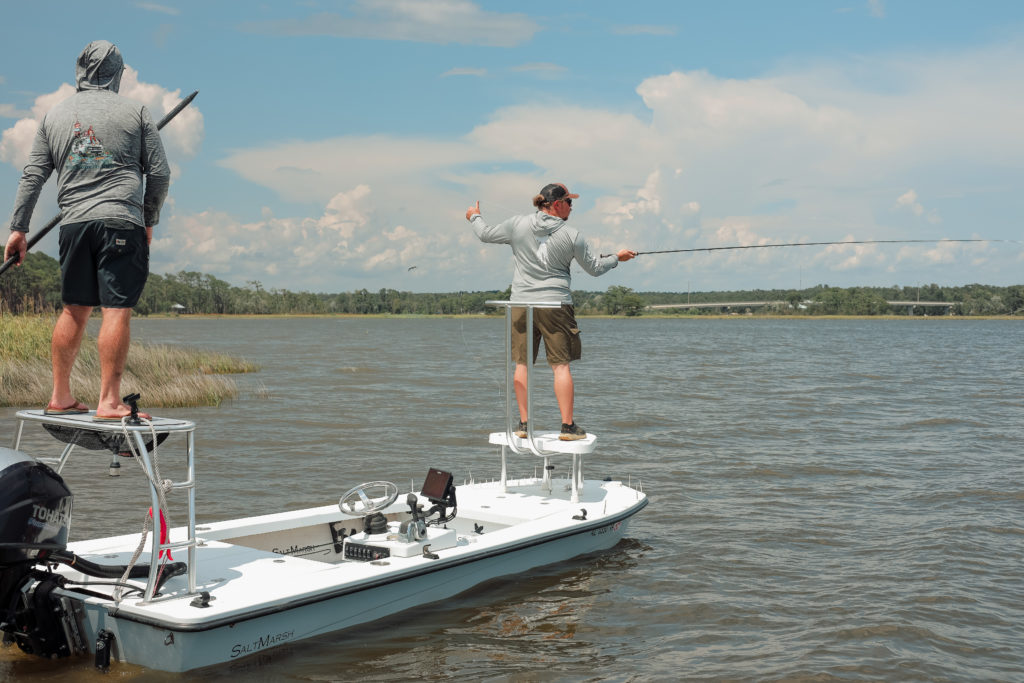
A Growing Community
The Eastern Shore Fly Fishers Club currently has around 45 members, mainly in Mobile and Baldwin counties. Due to the membership reach, they rotate monthly meeting locations to try to accommodate all. The first Tuesday of the month is usually an educational meeting open to the public, with local guides and conservation experts teaching about specific fish and tactics. The third Thursday meetings are fly-tying nights where a professional leads the members through a new pattern.
“We have a pretty diverse mix of individuals, from younger anglers, anglers with young families, and retirees who are always willing to educate the next generation of anglers,” says Bearden. “Many of our anglers are men, but we have several women in the club who are often the better casters out of the group. There are no age restrictions or requirements to join, just a $50 membership fee to help us pay for fly-tying materials for our monthly tying gatherings, while students (elementary through college undergrad) are free to join.”
Along with the regular meetings, the ESFFC also has several tournaments and events throughout the year to encourage folks to get out and fish. One of those is the Angler of the Year tournament, where anglers have from February through December to target several of the sport fish in the area to earn points, and the angler with the most points at the end of the year wins. The group has also been active with the Tripletail Classic, which is a catch-tag-release tournament where anglers target tripletail exclusively on the fly during the summer. He encourages people to reach out and says the best way to stay up to date with the meetings and events is to follow the club on Instagram at esflyfishers.
The inaugural Tripletail Classic was held in May of 2020. After monthly fly-tying nights at Spencer’s Fairhope Fly Shop, a few ESFFC members met up for beer at the Flybar and came up with the idea of hosting a fly-fishing tournament to unite and grow the local fly-fishing community. They chose the tripletail species for a reason. “They are great for new or part-time fly anglers and catching them doesn’t necessarily require an immense amount of local knowledge, making it accessible for anglers of all levels,” says Danielle Davidson, one of the tournament originators.
“The Gulf Coast Research Laboratory tripletail tagging program has over 30 years of research and data, and we wanted to introduce anglers to another way to find gratification in tripletail angling beyond ‘filling up the box.’ The Tripletail Classic directs all proceeds annually back into fisheries research and related educational activities.”
In 2022, the tournament added a marine debris category that encourages anglers to collect a bag of trash while fishing, which then enters those participants into a drawing for high-end prizes. The marine debris prize is a clever way of promoting a cleaner waterway and appears to be trending through local tournaments.
Emily Glasgow received a point for a bag of trash when she won the 2024 Mixed Bag Award at the Gulf Coast Classic Tournament in Gulf Shores this past May. At only 26 years old, Emily caught the greatest number of different species. “It really required you to think outside the box,” she says,“and challenged us as to how to catch the most variety of fish in the time frame given. We used everything from trout flies to catch finger-mullet to big streamers to catch Spanish Mackerel. We didn’t sleep much during those two days.”
To win, Emily caught 13 different species on a fly, including a grunt, pinfish, bass, redfish, catfish, Mangrove Snapper, and speckled trout, among others. She caught her variety of fish in spots ranging from the Three Rivers region to the Perdido Pass area. Emily also received the Unique Catch Award for a grass carp. “I noticed they were having a feeding frenzy on these little seeds blown on the top of the water. So, I broke out the trout box and threw every single nymph I could imagine. But I had this one little bitty size 16 and I threw it out there and it kind of mimicked the little seeds, then I caught that grass carp. Those things are very hard to catch,” says Emily.
But with Emily’s outlook, the challenge is welcomed. “There is not a type of fish I hate catching,” she says. “They say the ‘tug is the drug’ and that is the truth. There’s something about the eat of a fly and the fight of a fish on a fly rod that just keeps you coming back for more.”
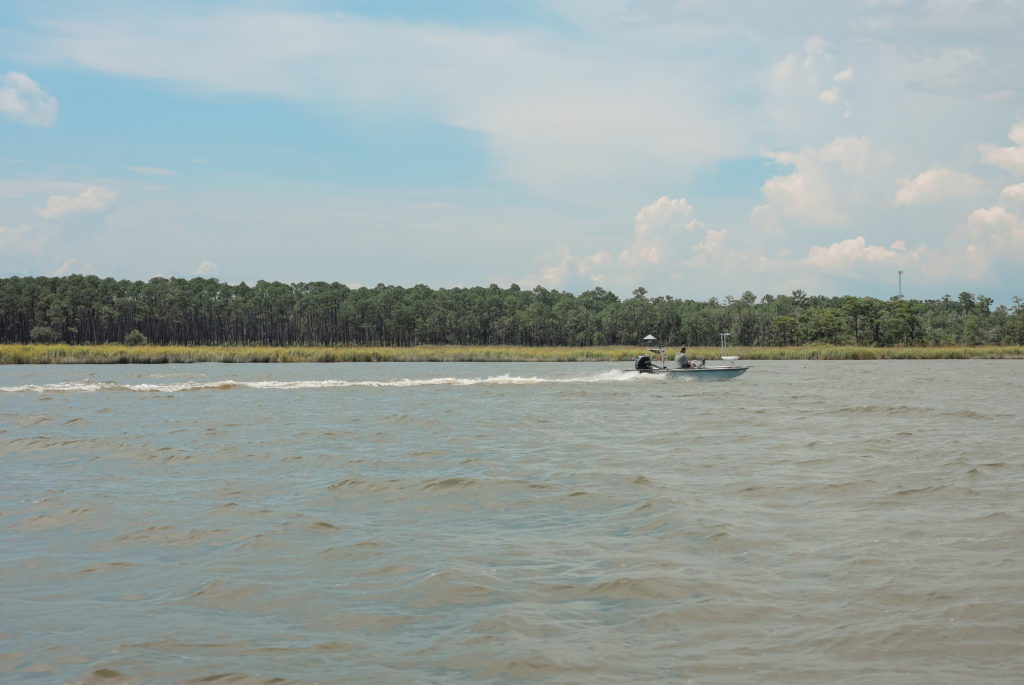
The Next Generation
The open-minded perspective helps with such a seasonal fishery. Peter Jordan, owner of Lost Angler, a local online fly shop, says: “The pro of Mobile Bay is that there are a ton of different species. The con is that it can be tough to learn because it is seasonal. Just like a menu at my favorite restaurant. It may not always be a good day to order veal or oysters, but it’s always a delicious day to come to the restaurant. That mindset makes it a lot easier. So, you have to be flexible and change what you are fishing for depending on the time of the year, which can be tough for new fly anglers, because it’s a lot easier to come in and learn one species.”
While in college in 2007, Peter started the University of South Alabama’s bass fishing team. He soon grew tired of the egos and wanted to take his own uncharted journey. He quickly realized that he could create a fly into any lure he wanted and that practicing his cast at night under the streetlights was the perfect salve from the pressures of the day. He started going to the casting seminars at McCoy Outdoors in Mobile but was too nervous to approach Jimbo Meador and ask for tips. So he read books and watched lessons on YouTube.
“I remember reading Thomas McGuane’s 92 in the Shade and one character was trying to understand Permit [fish] and went out on a skiff and sat there for an entire tide change just watching,” he says. “So, I took my kayak down to Dog River to a flat by Perch Creek. No rods, I just anchored, took me a sandwich and some drinks, and waited and watched for four and a half hours. I watched those fish come onto the flat and learned how they fed and how they moved and what they did and the whole nine yards. Suddenly I started studying bull minnows and tying flies that look like bull minnows. Then I started studying what the shrimp look like and how they change colors throughout the year. And it gave me so much more of an appreciation for the Bay and places that I once thought were simply empty mud flats and realizing how teeming with life they really are. This changed my outlook and I started to appreciate different parts of Mobile Bay. For instance, the Causeway is vastly different from the middle of the Bay around Dog River and Weeks Bay. Bon Secour Bay is so different than the Mississippi Sound. Fort Morgan and Navy Cove are vastly different from Dauphin Island even though they are a few miles apart. Each one has its own character, just as one might say the people in those areas have their distinct characteristics. And that was probably the big change for me in my fishing, in that I realized that fly fishing was so much more than chunking a bait. With bass fishing, it’s about getting as many casts as possible in to really work that waterbody. Fly fishing is much more like bow hunting. It’s not ‘how many shots can I make,’ it’s ‘how close can I get to understanding that fish before I take that one shot.’ And once I realized that, it changed my entire world. And after that, I never picked up another spinning rod again.”
Peter opened the Lost Angler in Daphne – it became an exclusively online operation in August – which had filled the void left after the closure of the Fairhope Fly Shop. The fly master who Peter was too intimidated years ago to approach would come to his shop often. Lost Angler even hosted a “Jimbo Meador and Friends’ Redfish on the Fly Tournament” last November. “When I opened my store, my goal was to grow the fly-fishing community more than anything else. How do we get more people involved, having fun and learning? And then, how do we get them to understand and get involved with what Baykeeper and SALT are doing. To get people to understand that when you see the world on such a smaller level and see our bay and see our rivers and everything it touches, you realize just how interconnected and fragile it is. And I want my kids to be able to enjoy it. So that’s been the overarching goal of Lost Angler. And who knows, if I’m lucky, I’ll screw up and sell some fly-fishing equipment too.”
(Click photo to enlarge)
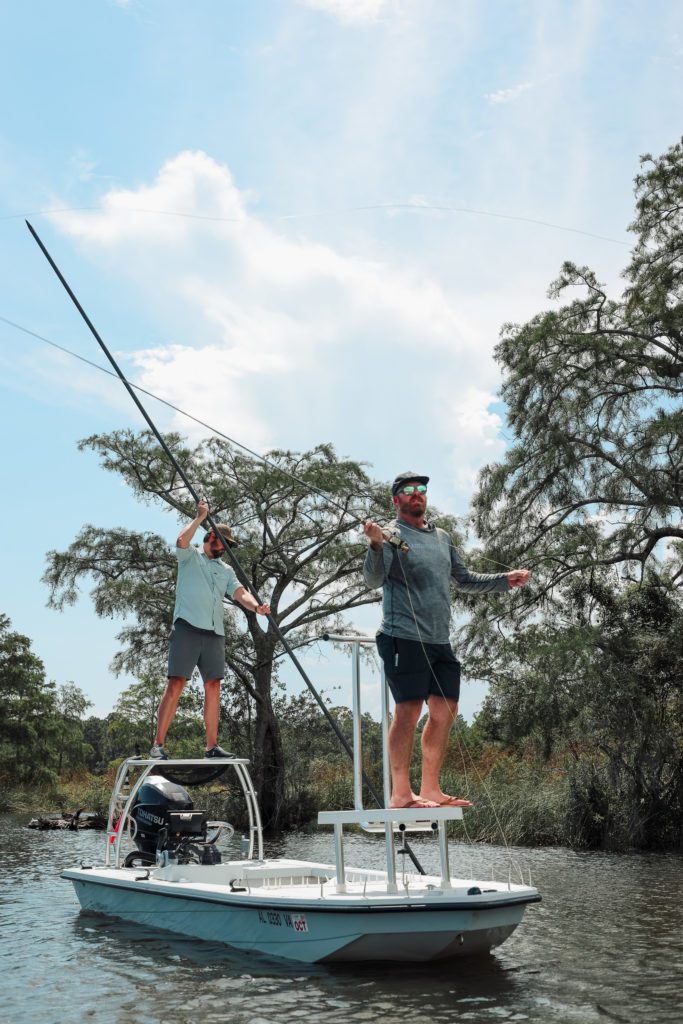
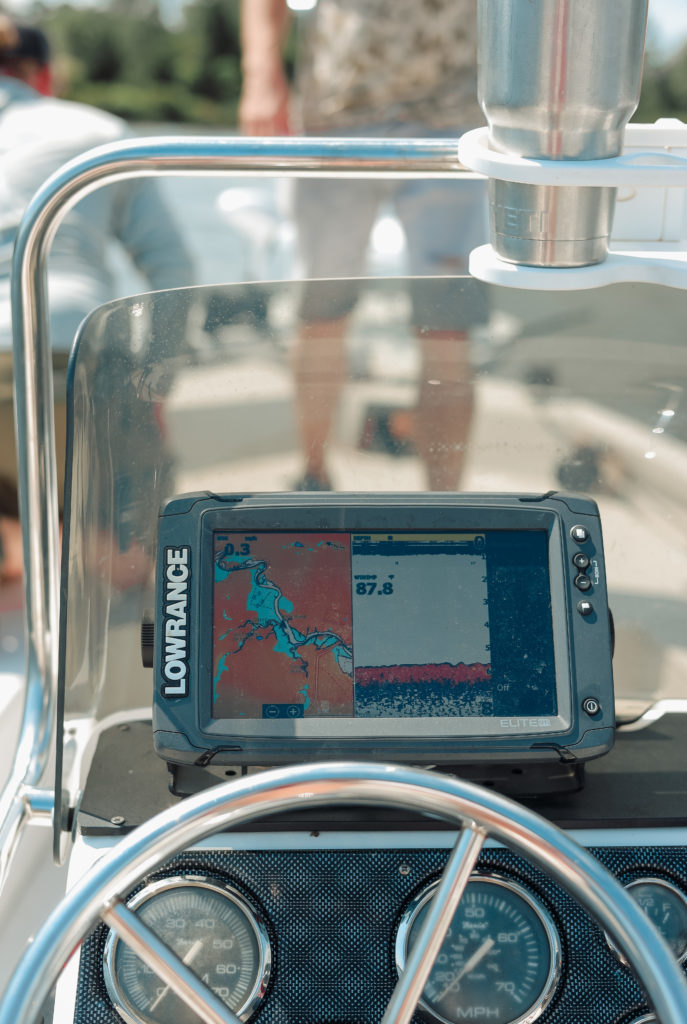
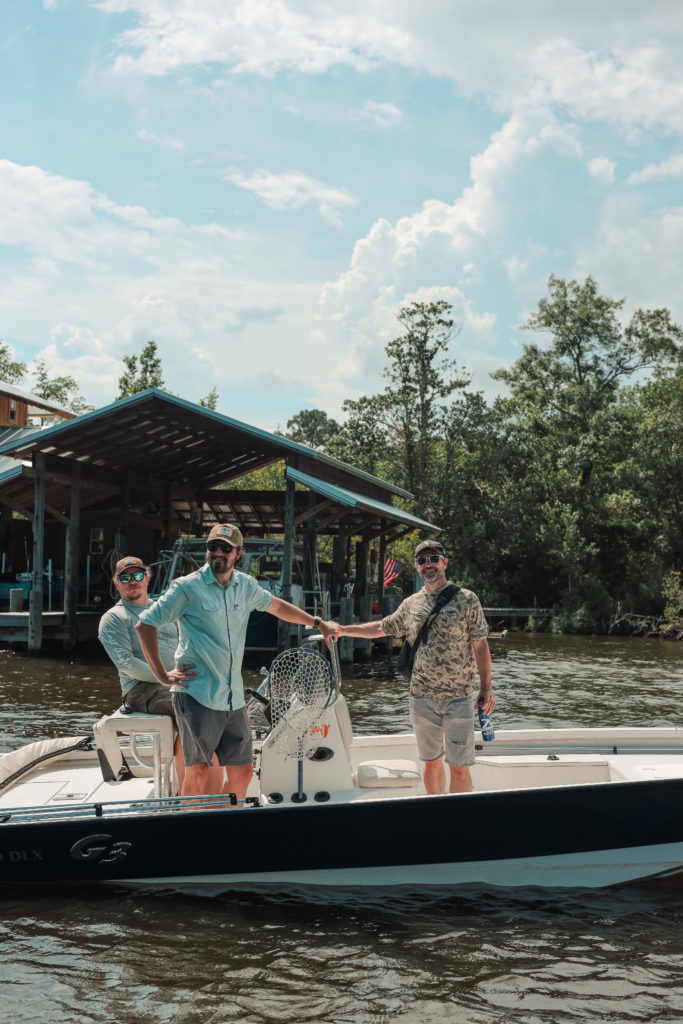
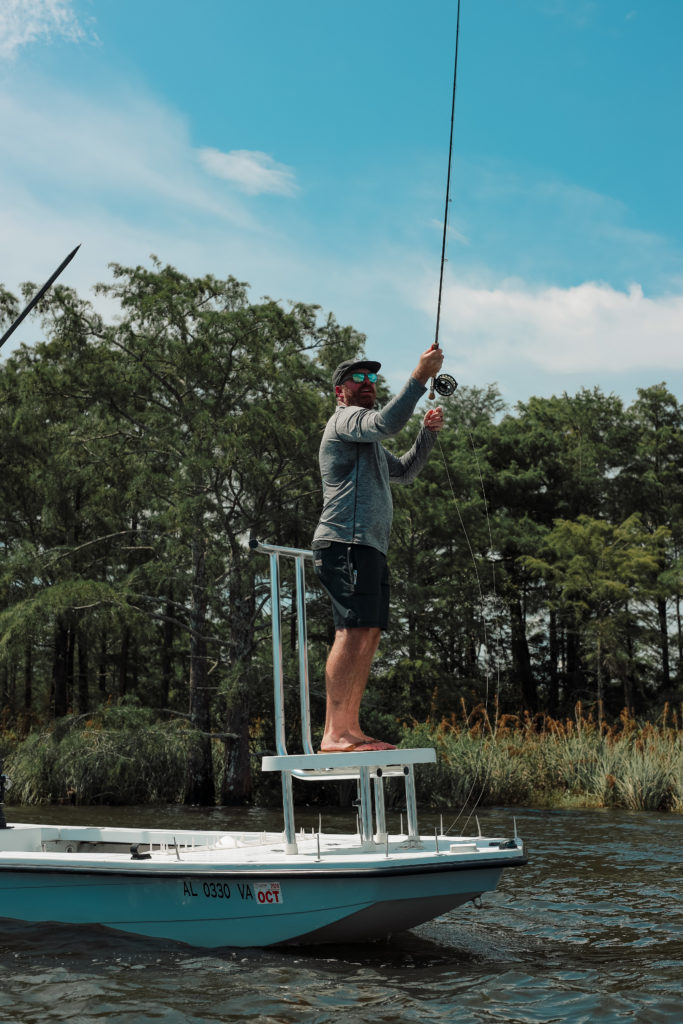
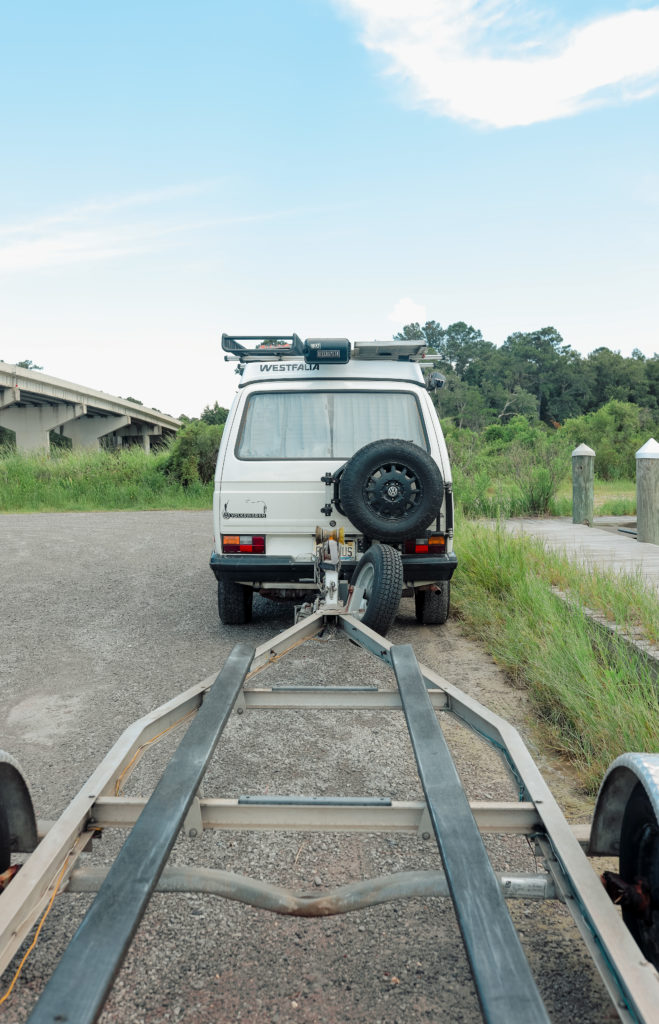
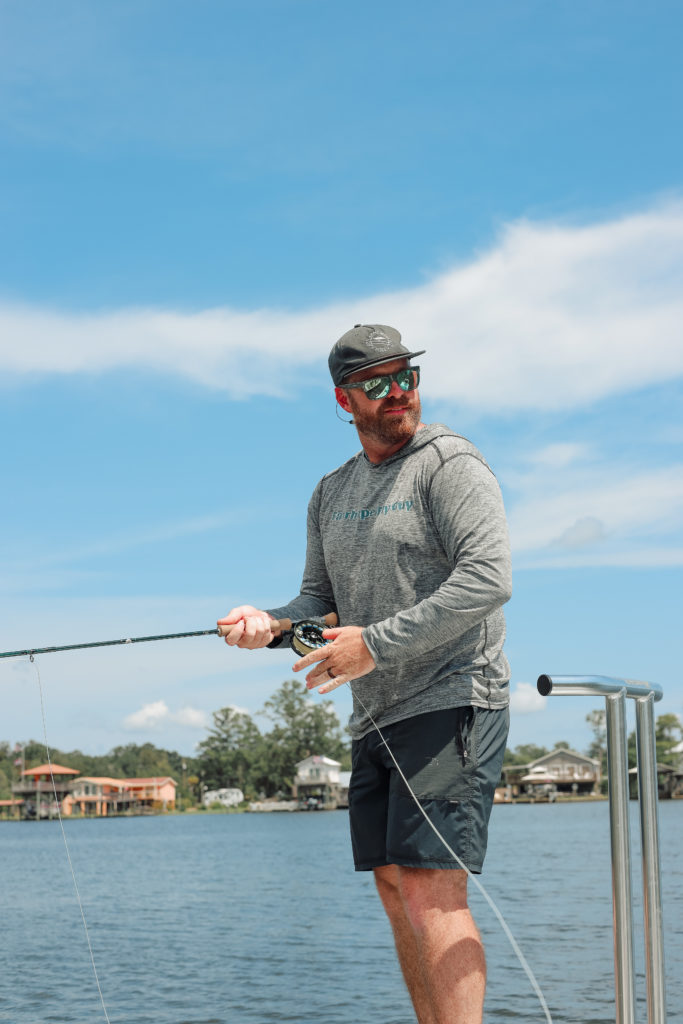
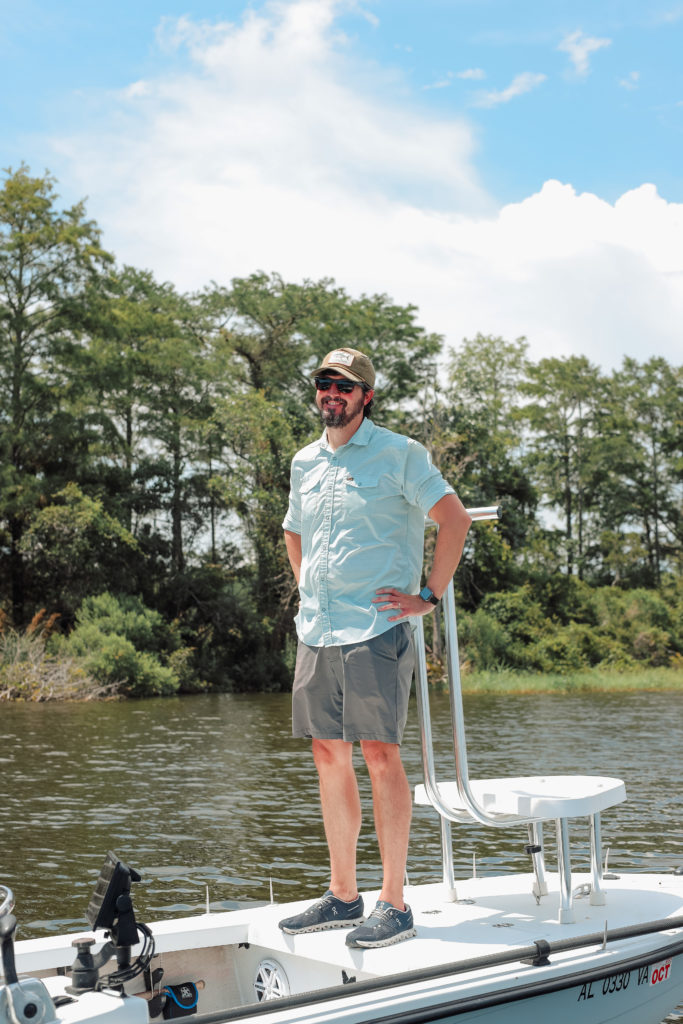
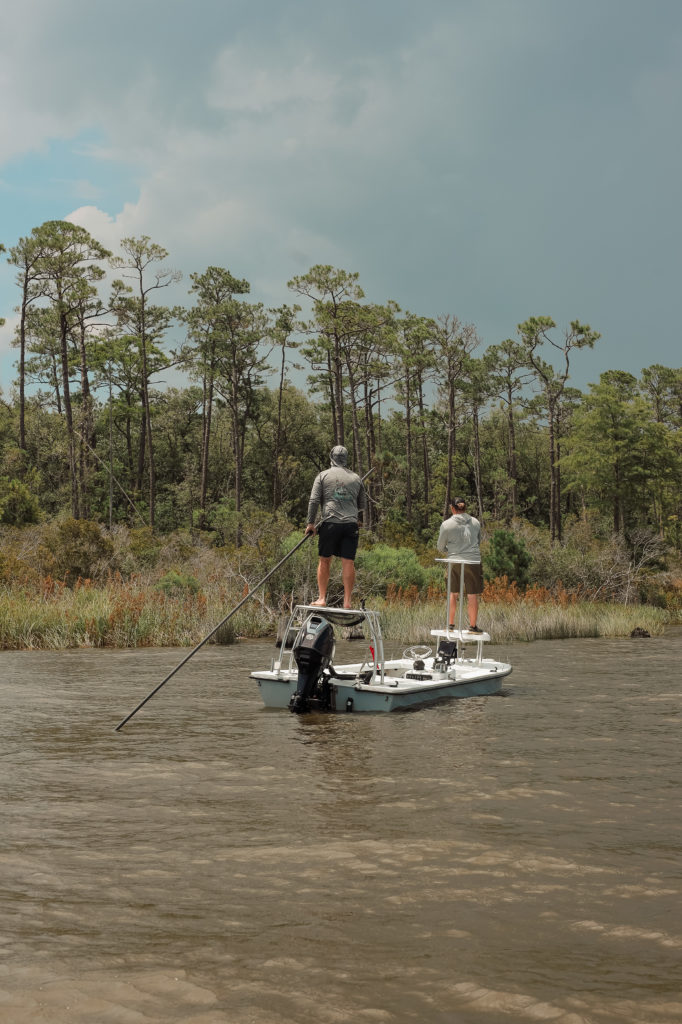
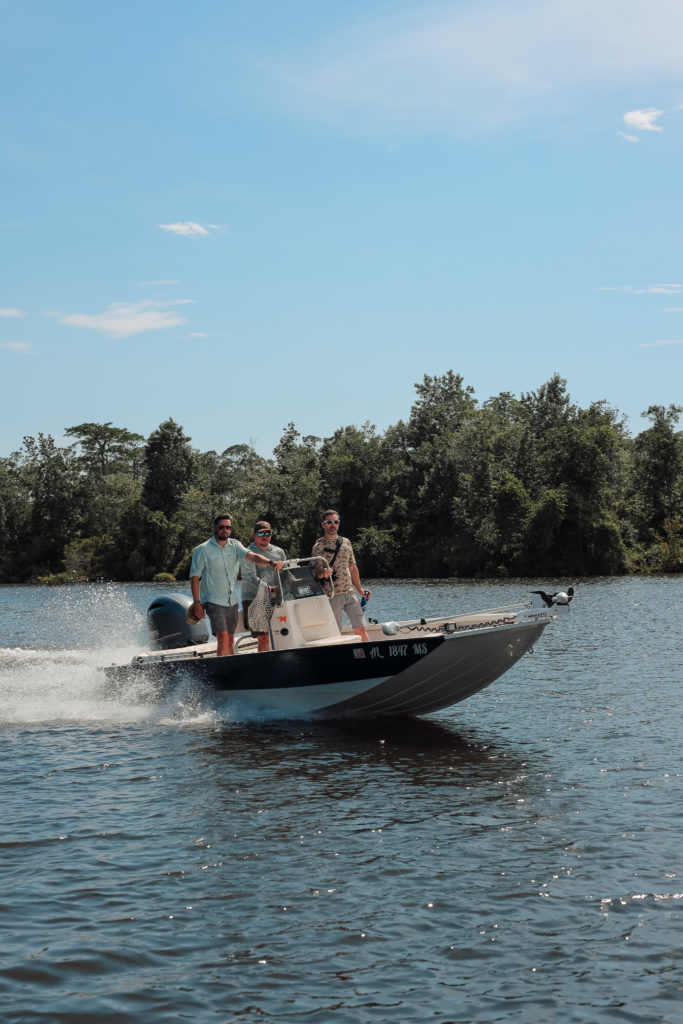

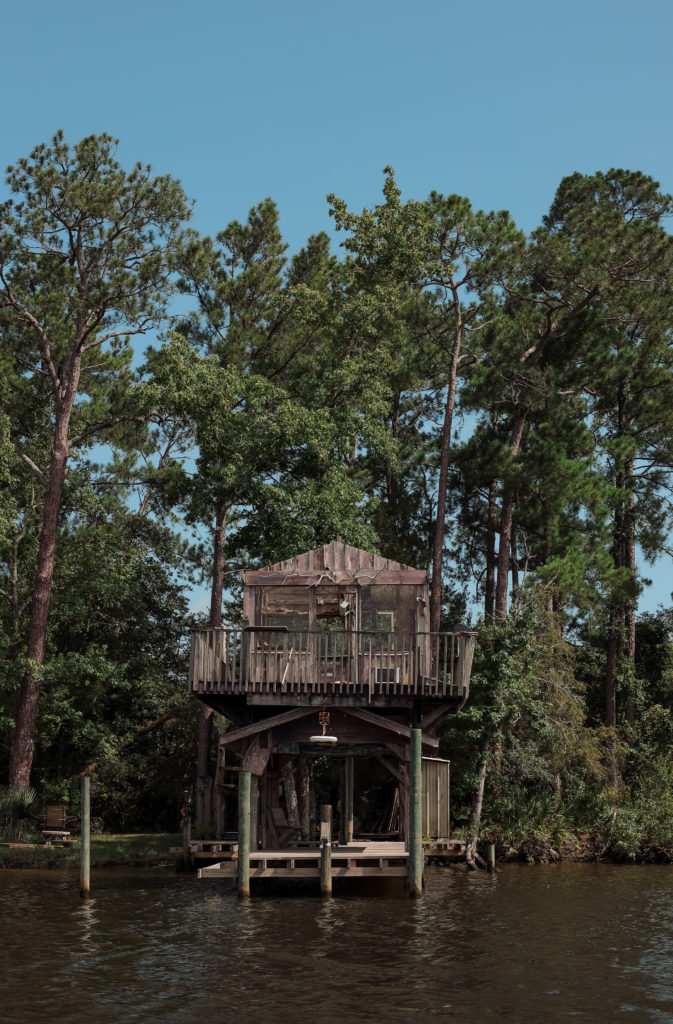
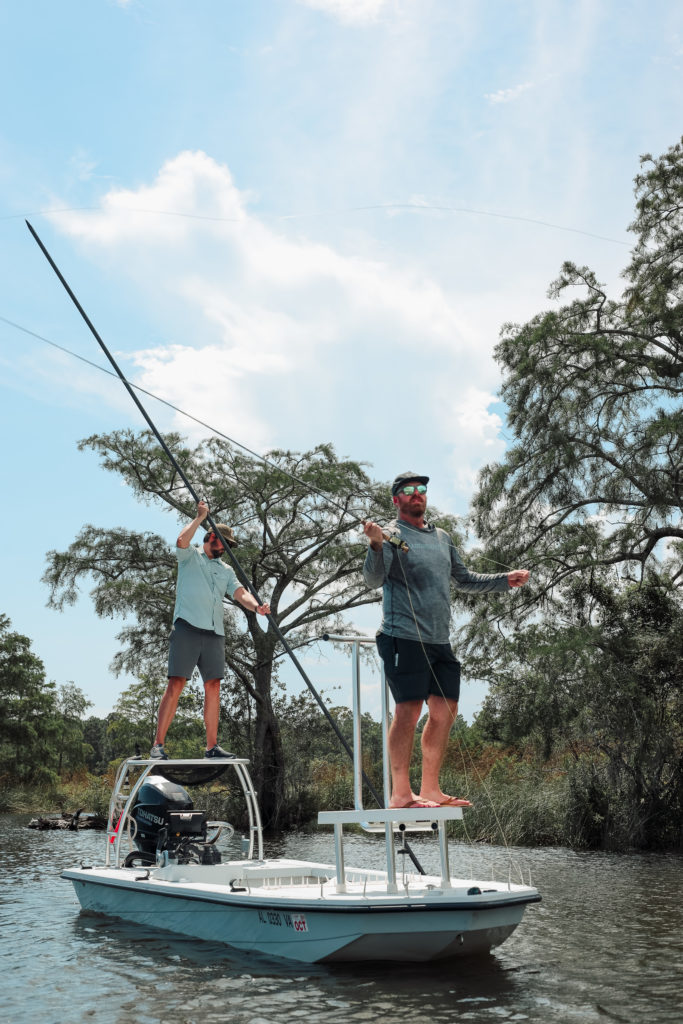
Peter’s personal favorite fly for the Mobile Bay area is a Bead Chain Seaducer. “I have caught every species you want to catch in Mobile Bay on this fly,” he says. Peter loves catching redfish in the fall and the comradery of having a buddy poling on the platform while you’re casting, but he says, “If there’s one fish that just gets my goat and keeps me up at night — it’s striped bass.”
Lost Angler is working with the Alabama Department of Conservation and National Resources to help rebuild the Gulf stripers population. “This is our steelhead,” Peter says. “A species that would go into the Gulf every year and come into the rivers to spawn. And our area used to have a tremendous stripers population. ADCNR is doing a tremendous job of trying to rebuild that population, which is still extremely fragile. Those fish can be fussy, they can be picky, and they pull like an absolute freight train. It’s our anadromous fish species and really tells the story of Alabama’s entire ecosystem. They are an amazing species. It’s Alabama’s sport fish that you can catch in Mobile Bay, Cahaba, Coosa and Tallapoosa. Name another like that.”
With the growing fly fishing community, there is a new generation of guides poling around Mobile Bay, more than this article has space to highlight. Sam Glass had his first job at age 16 working at a fly shop in Virginia. He moved to Mobile for college around 2004 to pursue marine biology until he realized there wasn’t much fishing involved. Sam got his first skiff in 2010 and officially started FlyWay Charters in 2019, but had been giving charitable trips long before with a good client list built up.
“Jimbo Meador was doing it long before I was, but he was no longer doing it when I started out. So, for a while, I felt that I was just discovering this whole new thing, but then I met Jimbo at the Bluegill and started talking and I just laughed at all this stuff that I thought I had found, had already been found,” Sam says. “Jimbo came up when he saw my flats skiff pull up at the restaurant. He thought it was his old one. So, we started talking and hung out a bit. With just a flat skiff or a rod or even a fly on a hat, you never know how much of conversation that can sprout.”
FlyWay Charters is located in Spanish Fort with lodging available, but Sam will launch in different locations depending on the client’s desires. He fishes from the Florida line to around Biloxi. Sam will take a conventional trip, but 95 percent of his trips are fly fishing. “Redfish was the intriguing factor for me. In the mountains of Virginia we had native trout, smallmouth, largemouth, needle nose gar, but I was always hunting that bigger tug,” he says. “We’ve also caught 30-lb to 40-lb and sometimes over 60-lb black drum out here. And that’s a big fish to tug on a fly rod that doesn’t see very well and the fly has to be really well presented,” says Sam. “And I strictly do sight fishing. I love the one-on-one, or, if you see a school, it’s you versus the school of fish to make them want to eat. I think getting that close to that creature adds so much to the experience. You can do the same sight fishing on conventional light tackle, but fly fishing adds a lot of art technique to it. I always say when we’re fly fishing, we’re really stalking these fish, it’s more hunting than fishing.”
Blake Walters grew up in the Grand Bay area and started out fly fishing in a pond when he was a kid. Later, meeting Spencer and others with the ESFFC only accelerated his interest in saltwater fly fishing. At age 36, Blake left the corporate world and decided to put his fate in his own hands rather than someone else’s and started a fly charter business under the name “Fairhope Fly Guy.” Blake says, “The traditional fly angler is very methodical and purposeful in every aspect of the art, which I found attractive. It’s more than just picking up a rod and going. It’s a process.”
Blake’s favorite fly is the Squimp, a mix of shrimp and squid pattern. “Peter at Lost Angler makes fun of me because I talk about it all the time, but I do think it’s the greatest,” Blake laughs. “I’ve caught everything from pinfish all the way up to large redfish and jacks, just about everything really.”
Blake will fish any waters from Moss Point, Mississippi, to Perdido Key, Florida. “Most of my clients are out-of-town and want the saltwater species, mainly redfish, so I’m typically at the south end of the bay.” But Blake loves to explore the remote oxbow lakes of the upper delta as much as he values the marshes and creeks around the Mississippi Sound and Fort Morgan.
“Ultimately, Mobile Bay is extremely attractive because of the diversity,” he says. “I’ve caught flounder, redfish, largemouth bass, speckled trout, and bream on the same point near the Causeway. Also, smallmouth buffalo is a species not a lot of people around here target, but it is a native species and they are a blast to catch. They are all over the Causeway in the fall.”
Blake grew up around the Bay and echoes our concerns for the future. “One major negative for Mobile Bay is the clarity. That’s what Baykeeper is known for — fighting for a cleaner estuary, which I’m all for. But that’s the real struggle, I’m trying to sell sight fishing to my clients and that’s the biggest appeal on my end, but if you cannot see the fish, then it’s not a viable option. And that’s the pro and con, we have a phenomenal level of diversity, but at times it’s tough to see them.”
Jimbo Meador, and others from his generation, remember the clear days and have seen firsthand the water clarity worsen over the years. “When I was kid, I could spear fish in Mobile Bay and shoot sheepshead and flounder. I live in Point Clear and we used to have eel grass halfway out our pier,” he says. “That’s the nursery grounds for everything. All our shrimp, crabs, and fish. But we’ve destroyed the habitat. We used to get softshell crabs right off the pier, but they don’t have anywhere to hide anymore. The grass holds the sediment down, but now, without it, if you get a little wave action you stir the sediment up. Real simple — if you put a tarp over your yard, the grass isn’t going to grow. Well, the muddy water is just like a tarp.”
Mobile Baykeeper lists the recovery of seagrasses as a core goal in its mission statement. It’s a multi-faceted, uphill battle, but there’s simply no reason to accept the current condition as some new normal. Unfortunately, when Jimbo speaks of the lush eel grass under the piers and spearfishing in the clear shallows of the bay, most of us need our imagination, as those images only exist in the memories of an older generation. I have visited the area throughout my life and moved here in late 2008 but have never known that version of Mobile Bay. As Jimbo says, “Each generation loses something, but they don’t know what they lost because they never saw it.” Fortunately, we have folks like Jimbo around to tell us what we’ve lost, and to remind us of what we’re fighting for.
